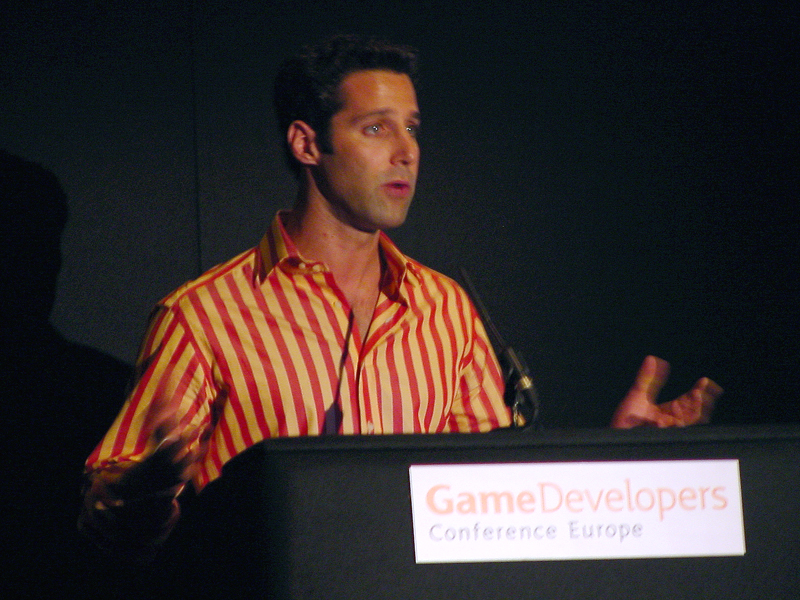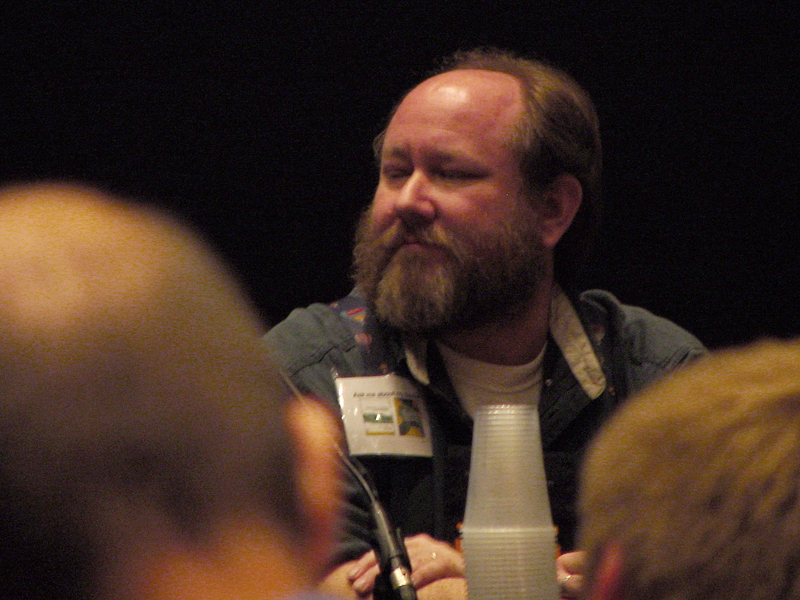|
GDCE and the Academic Summit: Researching the Future of Games
|
||
|
"Future" was the watchword at this year’s Game Developers Conference Europe, where academics and developers from all over the world met to discuss and debate what lies ahead for the games industry.
In the lecture halls, in the lobby, and in the pubs surrounding Earls Court, people talked about consolidation and the role of the small developer, voicing concerns about the prominence of licensed content over new, creative IP. Even students attending the conference on scholarships from the IGDA seemed painfully aware of the difficulties they faced as potential designers, programmers, and artists. But beyond “big-picture” issues, one factor seemed to surface repeatedly – the promise (or threat) of “next-generation” hardware.
This year, no less than 7 individual sessions addressed the impact of next-generation consoles, touching upon everything from programming and graphics to business and marketing. Panelists and audience alike speculated about how the next round of machines would affect teams, timelines, budgets, and consumers. Should developers be worried or elated about the rise of these machines? What is the real potential behind the conjectured specifications?
Graphics, Gameplay and AI
While others echoed these sentiments, panelists did not always agree on how these goals should be pursued given the current development climate. On a “next-gen” game design panel, veteran developers debated the pros and cons of mainstream acceptance. While John Hare encouraged designers to work creatively with licensed content, Dean Carter championed the underdog: interesting, original IP. Ernest Adams called for improvements in writing, while Demis Hassibis stressed the need for experimental gameplay and stronger AI.
Should innovation come at the expense of larger audiences? There were certainly mixed feelings about the subject. This was especially clear during the “Death Match” fireside chat with Gary Penn and Peter Molyneux. Lionhead's lead held fast to his vision of persistence and character development in games - despite strongly worded, practical-sounding arguments from Gary Penn about the difference between games and research.
How to sort it all out? Many of the problems piled up in the heap for “next-generation” hardware are incredibly difficult – some qualify as PhD research. Given the timeline and budget of a typical development project, will publishers and developers really be willing to invest in R&D? Should they look elsewhere for help and inspiration, or just skip it all together?
Academics Ponder
Many of these questions surfaced again at the IGDA’s Academic Day – which took place on the last day of the conference. Half presentation, half discussion, the gathering aimed to create concrete proposals for integrating the needs of developers (as those outlined above) with the interests and research programs of academics.
Highlights of the critical debate included Matteo Bittanti's rousing manifesto about the lack of intelligent criticism and analysis in the popular press, Helen Kennedy's analysis of gender, content and mainstream market success, and Seamus Blackley's engaging, if discouraging talk about publishing alternatives.
But after the conference ended, I could not shake the feeling that the future game development and research was incredibly hazy. Better gameplay, stronger AI, more education, diverse staff... improved publishing models? What are the long term goals for games research in the academy and development community? How can we work together to realize these goals?
Two Sides of the Same Coin?
Publications on game AI as recent as 2002 suggest that simple techniques are best - that hand-scripted agents and simple Finite State Machines will rule the day. And many successful shooters are built in this way. Consider this quote from a guide for the popular game, Splinter Cell. It describes the beginning of the game's final (and presumably most exciting) level:
"Shoot guard in far corner below light - then shoot the dog. Can actually shoot dogs anywhere, nobody notices their bodies. Now move along and kill the other two. Shoot guard outside of search light range, or just ignore him and only kill the dog. You can negotiate around the guard's path. "
Soldiers with robotic, pre-scripted paths that can be easily circumvented? Dogs that don't notice falling bodies or smell blood? It sounds terrible - and it looked terrible as I watched a friend play. But he loved this game.
Halo, which used emotions, short-term memory and context-dependent beliefs and barks to augment its combat AI, is roundly hailed as a masterpiece of AI programming. My Splinter Cell friend loved this game too. For each context, each design, the AI satisfied his need to feel clever, powerful, and entertained. Which one of them is "better"?
Better By Design
Clearly, as players come to expect increasingly realistic and dramatic behavior from games and game characters, game systems will become more complex. Where that complexity emerges will most likely depend on the design of the game itself. But that sounds pretty fuzzy, too.
Perhaps the best way to approach this question is from the perspective of balance.
Opening the development community to the diverse populous of the academy will encourage fresh gameplay, themes and content, while collaboration with industry will help ground experimentation in the realities of budgets, timelines and market demographics. And as the market grows, new models for licensing and distribution may emerge.
Advanced hardware will certainly give both communities the opportunity to implement faster algorithms for path-finding, sensing and agent coordination – but communication, arbitration and synchronization will remain an issue. Simultaneous development of a game's design, AI, and narrative will improve the flexibility and reactivity of finished products – but good tools for analyzing and editing these systems (and how they interact and overlap) will be required.
In the end, balancing innovation with an understanding and appreciation of how and why games are successful is key. There might not be any silver "next gen" bullets, but there will be plenty of opportunities for industry and academia to collaborate – designing, planning and building a brighter future, together.
Robin will be speaking at GDC 2004 in San Jose, helping with the Game Design and Tuning Workshop, and the 2004 Experimental Gameplay Workshop. She is also co-organizing a workshop on New Challenges in Game AI for the 2004 AAAI conference.
Email her at: hunicke@cs.northwestern.edu or visit her at www.cs.northwestern.edu/~hunicke
|
||
 In
Great Game Graphics – Who Cares?, Naughty Dog’s Jason Rubin took a
hard look at past, present and future of game graphics. Starting with
early Atari-quality graphics and moving forward to today’s texture-mapped
wonders, Rubin demonstrated that today’s game avatars can not rely on the
strength of poly-counts alone. Rubin maintained that users are looking for
believability – what he calls “a fully 3D personality”. Acknowledging the
continued importance fluid, believable animation, Rubin encouraged
developers to secure current audiences and entice new buyers with
innovations in game design, aesthetics and AI.
In
Great Game Graphics – Who Cares?, Naughty Dog’s Jason Rubin took a
hard look at past, present and future of game graphics. Starting with
early Atari-quality graphics and moving forward to today’s texture-mapped
wonders, Rubin demonstrated that today’s game avatars can not rely on the
strength of poly-counts alone. Rubin maintained that users are looking for
believability – what he calls “a fully 3D personality”. Acknowledging the
continued importance fluid, believable animation, Rubin encouraged
developers to secure current audiences and entice new buyers with
innovations in game design, aesthetics and AI.  Conventional
wisdom about new console hardware states that stronger (and perhaps,
parallel) processors will allow developers to produce “intelligent”
opponents, “believable” characters and “interactive narratives”. In Penn's
estimation, many of these things simply aren’t feasible (or necessarily
desirable) for commercial game development projects.
Conventional
wisdom about new console hardware states that stronger (and perhaps,
parallel) processors will allow developers to produce “intelligent”
opponents, “believable” characters and “interactive narratives”. In Penn's
estimation, many of these things simply aren’t feasible (or necessarily
desirable) for commercial game development projects.  Ernest
Adam's questions about the quality and training of current and future game
industry employees fueled a greater part of the afternoon discussion,
while Richard Evans' notes on persistence and context in games highlighted
the importance of design innovation and experimentation within game
studies.
Ernest
Adam's questions about the quality and training of current and future game
industry employees fueled a greater part of the afternoon discussion,
while Richard Evans' notes on persistence and context in games highlighted
the importance of design innovation and experimentation within game
studies.  Over
the last two or three years, I've heard two distinct arguments with
respect to the value of new, risky technologies and research. One
maintains that simple, known tactics ("smoke and mirrors") will be enough
to engage and entertain consumers. The other encourages a slow but gradual
evolution towards complex simulation, dynamic behavior and
procedurally-generated experiences.
Over
the last two or three years, I've heard two distinct arguments with
respect to the value of new, risky technologies and research. One
maintains that simple, known tactics ("smoke and mirrors") will be enough
to engage and entertain consumers. The other encourages a slow but gradual
evolution towards complex simulation, dynamic behavior and
procedurally-generated experiences. As
research universities and vocational institutions create courses and
degrees for game studies, they will present students with both old and new
development methodologies. Understanding the history of games and their
cultural impact will help new hires understand their potential and chart
future directions.
As
research universities and vocational institutions create courses and
degrees for game studies, they will present students with both old and new
development methodologies. Understanding the history of games and their
cultural impact will help new hires understand their potential and chart
future directions.  Robin
Hunicke is a PhD candidate at Northwestern University in Chicago, USA. As
a joint member of the Robotics and Interactive Entertainment Groups, she
specializes in game AI.
Robin
Hunicke is a PhD candidate at Northwestern University in Chicago, USA. As
a joint member of the Robotics and Interactive Entertainment Groups, she
specializes in game AI.